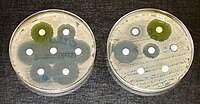
Photo from wikipedia
Abstract Background Antibiotic consumption is considered a major driver of antibiotic resistance, but it remains unclear whether the consumption–resistance relationship is apparent for many organisms and drugs, and whether aggregate… Click to show full abstract
Abstract Background Antibiotic consumption is considered a major driver of antibiotic resistance, but it remains unclear whether the consumption–resistance relationship is apparent for many organisms and drugs, and whether aggregate consumption is the best predictor of resistance. Methods We conducted a landscape assessment of the consumption-resistance relationship by comparing a 20% sample of Medicare Part D outpatient antibiotic pharmacy claims with a nationwide survey of hospital antibiotic susceptibility reports. Antibiotic consumption was summarized in individual states and hospital-referral regions (HRRs) using traditional, aggregate consumption or by metrics that account for the concentration of consumption in a few individuals (Gini coefficient). The consumption–resistance relationships for 17 organism–drug combinations were simultaneously evaluated (Spearman’s rho; linear models predicting resistance from aggregate consumption and Gini coefficient) and corrected for multiple-hypothesis testing (Benjamini–Hochberg). Results We identified a significant correlation between aggregate consumption of an antibiotic and an organism’s reported resistance to that antibiotic in only a few cases: quinolones and E. coli (Spearman’s rho = 0.65, adjusted P < 10−4) and E. cloacae (rho = 0.50, adjusted P = 0.006). In other cases, notably E. coli with trimethoprim–sulfamethoxazole, the distribution of antibiotic consumption among consumers has a marginal relationship with antibiotic resistance (−1.0 p.p. resistance per p.p. Gini coefficient of consumption among consumers, unadjusted P < 0.001). Conclusion There is a clear correlation between aggregate consumption of an antibiotic and resistance of an organism to that antibiotic in only a few cases, suggesting that antibiotic steward efforts might maximize their effectiveness by focusing on particular organisms, drugs, and consumer groups rather than overall, aggregate consumption. Disclosures All authors: No reported disclosures.
Journal Title: Open Forum Infectious Diseases
Year Published: 2017
Link to full text (if available)
Share on Social Media: Sign Up to like & get
recommendations!